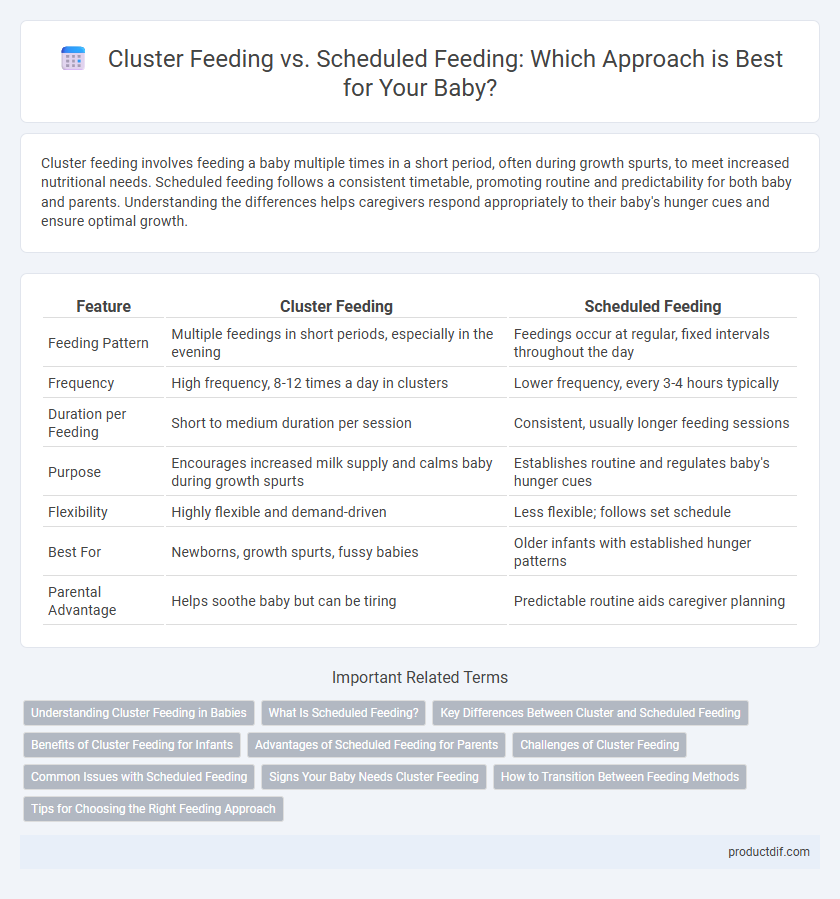Cluster feeding involves feeding a baby multiple times in a short period, often during growth spurts, to meet increased nutritional needs. Scheduled feeding follows a consistent timetable, promoting routine and predictability for both baby and parents. Understanding the differences helps caregivers respond appropriately to their baby's hunger cues and ensure optimal growth.
Table of Comparison
| Feature | Cluster Feeding | Scheduled Feeding |
|---|---|---|
| Feeding Pattern | Multiple feedings in short periods, especially in the evening | Feedings occur at regular, fixed intervals throughout the day |
| Frequency | High frequency, 8-12 times a day in clusters | Lower frequency, every 3-4 hours typically |
| Duration per Feeding | Short to medium duration per session | Consistent, usually longer feeding sessions |
| Purpose | Encourages increased milk supply and calms baby during growth spurts | Establishes routine and regulates baby's hunger cues |
| Flexibility | Highly flexible and demand-driven | Less flexible; follows set schedule |
| Best For | Newborns, growth spurts, fussy babies | Older infants with established hunger patterns |
| Parental Advantage | Helps soothe baby but can be tiring | Predictable routine aids caregiver planning |
Understanding Cluster Feeding in Babies
Cluster feeding in babies involves frequent, closely spaced nursing sessions typically occurring during growth spurts or developmental phases, helping to boost milk supply and meet increased nutritional demands. Unlike scheduled feeding, which follows a rigid timetable, cluster feeding is driven by the baby's hunger cues and often happens in the late afternoon or evening. Recognizing cluster feeding patterns supports responsive parenting and promotes healthy weight gain and emotional comfort in infants.
What Is Scheduled Feeding?
Scheduled feeding involves feeding the baby at predetermined times throughout the day, typically every 3 to 4 hours, regardless of hunger cues. This method helps establish a consistent routine that can improve sleep patterns and make planning easier for caregivers. Parents often prefer scheduled feeding to monitor intake more accurately and promote predictable digestion cycles in infants.
Key Differences Between Cluster and Scheduled Feeding
Cluster feeding involves frequent feeding sessions close together during certain times of the day, promoting rapid milk production and soothing a fussy baby. Scheduled feeding follows a set timetable, offering meals at fixed intervals to establish routine and predictability for both baby and parents. Key differences include the flexibility and demand-driven nature of cluster feeding versus the structure and time-based approach of scheduled feeding.
Benefits of Cluster Feeding for Infants
Cluster feeding supports infants' nutritional needs by allowing frequent, shorter feeding sessions that promote better milk supply regulation and help soothe fussy babies. This feeding pattern encourages stronger bonding through increased skin-to-skin contact, which also aids in stabilizing the infant's body temperature and heart rate. Enhanced digestion and improved weight gain are often observed in infants who experience cluster feeding, making it a beneficial approach during growth spurts and developmental milestones.
Advantages of Scheduled Feeding for Parents
Scheduled feeding offers parents predictability and structure, making it easier to plan daily activities and rest periods. This approach helps improve the baby's sleep patterns, resulting in more consistent nighttime rest for both infant and caregiver. Establishing a feeding routine can reduce parental stress by minimizing uncertainty and enhancing overall family well-being.
Challenges of Cluster Feeding
Cluster feeding poses challenges such as frequent, prolonged nursing sessions that can lead to maternal exhaustion and difficulty in managing daily activities. Babies who cluster feed often demand feeding every hour for several hours, disrupting sleep patterns and increasing parental stress. This feeding pattern may result in concerns about milk supply, necessitating close monitoring to ensure adequate infant nutrition.
Common Issues with Scheduled Feeding
Scheduled feeding can lead to issues such as insufficient milk intake and increased fussiness in infants, as it may not align with their natural hunger cues. This rigid approach often results in dehydration or inadequate weight gain due to missed feeding opportunities. Parents may also experience increased stress and difficulty maintaining strict feeding times, impacting both the baby's and their own wellbeing.
Signs Your Baby Needs Cluster Feeding
Signs your baby needs cluster feeding include frequent hunger cues such as sucking on hands, fussiness, or rooting behaviors multiple times within a short period. Newborns often cluster feed during growth spurts to boost milk supply and support rapid development. Recognizing these signs helps caregivers respond promptly, ensuring optimal nutrition and comfort for the baby.
How to Transition Between Feeding Methods
Transitioning between cluster feeding and scheduled feeding requires gradual adjustments to your baby's routine, starting with lengthening intervals between feeds by 15-30 minutes every few days. Offering a consistent feeding environment and closely monitoring your baby's hunger cues helps ensure they adapt comfortably to the new schedule. Consulting a pediatrician or lactation consultant can provide personalized guidance to ease the transition and maintain proper nutrition.
Tips for Choosing the Right Feeding Approach
Cluster feeding suits newborns with high hunger cues, offering frequent short feeds to boost milk supply and soothe fussiness. Scheduled feeding benefits parents seeking routine, promoting predictable feeding times that help establish sleep patterns. Assess your baby's hunger signals, sleep habits, and family lifestyle to select the feeding approach that supports optimal growth and emotional bonding.
Cluster Feeding vs Scheduled Feeding Infographic

 productdif.com
productdif.com